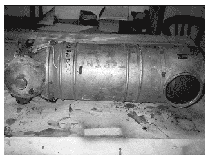Spring, summer, autumn ... warmth
Until the 1920s cars had practically no heating at all. Warm clothes from head to foot were the only functional solution. Although drivers and passengers made use of hot bricks and later catalytic heaters, it had been cold in the car, until a real heater was designed. However, it was not as easy as it might seem. At first, a reliable antifreeze had to be supplied.
From coat and hat
First automobiles, with mostly opened bodies, offered their passengers hardly any shelter and it was absolutely cold inside. Good clothing was the only weapon against cold.

Engelmuller´s advertisement in Sport a hry magazine from March 25, 1908. The company attended all domestic motor shows, including the first modest exhibition in Žofín in February 1904. Chilling cold was a good business for the tailor´s shop.
Stoke a briquette
First
devices for heating interiors were comprised of primitive tin boxes
into which briquettes were introduced. When ignited, they emitted
radiant heat through vents in the cover.

An advertisement text of the Mladá Boleslav car works (Sport a hry, no.16, from April 1908) should have rather admitted that "we all and also many others would chill to the bone in the car".
Catalytic heater
The catalytic heater was more reliable, although not very efficient yet. The heat was generated by chemical decomposition of petrol. A wide range of catalytic heaters were available from the 1920s to 1960s.

Autowarm heater.

The Therm X heater. Left, there is the device comprised of the petrol receptacle with the filling opening A, catalytic material C, covered with the lid G. Right, the device in the tin box.


Employing the exhaust heat
The heat generated by exhaust gases or coolant started to be employed for heating the car interior only at the end of 1920s, although first attempts in this respect appeared already before World War I. A serially produced heater on this principle appeared in the Ford A in 1929.

Practically the same additionally installed heater offered by Bosch in 1950-1960.
First independent heaters
The company Stewart-Warner was perhaps the first in the world to have come up with the first functional petrol-burning independent heater in 1937. In the Czech Republic such device appeared in 1942. It was installed to Siebel Si 204 aircrafts produced in Aero and ČKD. The heat was distributed by tubes to wing leading edges to prevent their icing.



Independent heater for the Siebel Si 204 aircraft.
Heater for the Karosa T500 HB
When the Karosa T500 HB mountain bus fitted with air-cooled Tatra engine appeared in the first half of the 1950s in the Czechoslovakia, the question of domestically produced independent heater was brought up for discussion. The electric heater did not meet expectations and therefore development of domestic independent heater was initiated.

The Tatra 500 HB mountain bus for which a domestic independent heater had to be developed.